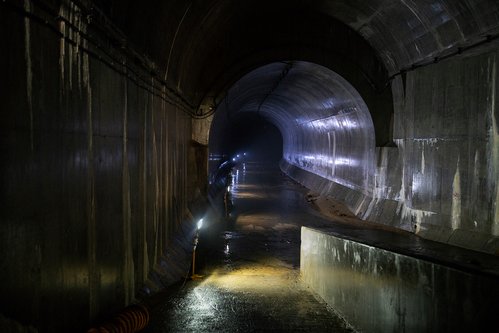Hong Kong’s vast $3.8 billion rain-tunnel network

Below the mountains that overlook Hong Kong’s financial district, drainage engineer Alex Lau is ankle-deep in water flowing into a giant tunnel almost twice the height of a double-decker bus.
Part of a ground-breaking, $3.8 billion (30 billion Hong Kong dollar) drainage network, this tunnel runs nearly the length of Hong Kong Island and has saved the city from floods that decades ago routinely cost lives and caused widespread destruction.
“This tunnel intercepts about one third of the rainfall for the northern Hong Kong area,” Lau says, as he looks west to the point where the tunnel fades to black. “We have about 34 intakes and all the intercepted water will be diverted into the tunnel and carried all the way to the sea.”
Dug with two vast tunnel-boring machines over five years, beginning in 2007, the 10.5-kilometer-long (6.5 mile) tunnel, about half the length of Manhattan, has solved a basic but pressing problem facing one of Asia’s wettest cities: rain. Hong Kong receives about 2,400 millimeters it per year, according to the Drainage Services Department (DSD). And about 80% of that water falls in just a few months.
But building this network in one of the world’s densest cities wasn’t easy.
Hong Kong Island was already criss-crossed by tunnels, carrying the city’s subway system and accommodating roads that slice through the mountainous landscape.
Consequently, the Hong Kong West Drainage Tunnel runs through the hills behind the city, tucked less than a dozen meters below the surface — though few of the city’s residents, whose lives it protects each rainy season, ever realize it is there.
Engineers had to shore up insecure ground above the tunnel to prevent water seeping through and causing parts of it to collapse. To tackle the difficulty of building tunnel intakes — pipes and entrances leading to the main drain — in dense urban areas, the decided to dig upwards from the tunnels and then extract gravel and debris that fell down out of the subterranean network to avoid causing too much disruption at street level.
Frequent flooding
A true Hong Kong summer can be a test of any resident’s love for the city. Stiflingly hot and humid, from June to September, high temperatures are only broken by typhoons and rainstorms, during which the city endures torrential downpours that render umbrellas useless.
Hong Kong has a color-coded warning system for rainstorms, from amber to black, issued by the Observatory and sent to millions of residents’ mobile phones. Building on a system introduced in 1967, the alerts warn people when to avoid unnecessary travel due to the danger of road accidents, or even landslides caused by rain in some mountainous parts of the city.
Offices and schools shut during black rain, which is defined as when more than 70 millimeters (2.7 inches) per hour. While black rain causes minor flooding — mainly due to the impermeability of tarmac and concrete — thanks to the giant underground tunnels, it is nothing compared to the past.
The deadliest typhoon hit the city in September 1906, killing an estimated 15,000 people, according to Hong Kong Observatory, 5% of the city’s then population of 320,000. In the 1960s and 70s, Hong Kong suffered hundreds of fatalities due to tropical cyclones. Thousands also lost their homes due to flooding, and the city had to spend millions on water damage repairs every year.
Heavy urbanization only made flooding worse, as large areas of natural ground were paved over, swapping soluble grass and mud for concrete and tarmac, which rather than absorb rain, allowed water to accumulate in puddles or, worse, cause flood. Older areas of the city were also compromised, with drainage systems built for a far smaller population and to poor standards.
Since 1995, the department has spent around $3.8 billion on various projects. That has included installing 2,400 kilometers (1,500 miles) of drains, 360 kilometers (224 miles) of river channels, four vast underground tunnels spanning 21 kilometers (13 miles), and four stormwater storage tanks. Another 11 tanks are being constructed.
The Hong Kong West Drainage Tunnel is the largest of four, and runs through the mountains above Tin Hau, in the eastern part of the island, past the busy financial districts of Admiralty and Central, to Cyberport on the western coast. At its widest, the tunnel is 7.25 meters in diameter.
It slopes gradually downward so the water is carried out by gravity, though pumps can also be engaged for heavy flow. Even on a dry day, water streams down a nearby intake from high above in the mountains. The intake looks like an artificial waterfall made of concrete steps designed to slow down the flow. Far from smelling like a drain, the water heading into the tunnel has little aroma, and looks a river.
Other solutions in Hong Kong are tailored to the district. So, rural villages and towns can be protected with dykes and channels dug to redirect or temporarily store the water, while heavily built-up, urban areas require more intensive engineering work.
These solutions, which direct rainwater away from vulnerable areas and eventually return it to the ocean, have helped to reduce the number of flooding blackspots from 126 in 1995, to just five today.
Richard Leung, the DSD’s senior engineer, won’t be drawn on whether all this has been value for money, but for context, flooding in southern China led to economic losses of more than $2.9 billion (20 billion RMB) in June alone.
Racecourse storage
One of the largest storage tanks in Hong Kong lies beneath one of its best-known landmarks: the Happy Valley Racecourse, where, before coronavirus, tens of thousands of gamblers bet on weekly horse races. Hundreds more use the grounds as an outdoor running track, football pitch, and rugby field during the rest of the week.
“You would never know this was here from the outside,” Lau says inside the tank. The concrete floor is streaked with mud and dotted with small puddles. Small stones, silt and leaves are partially lit by fluorescent lights that do little to illuminate the darkness.
The chamber looks like a vast, empty underground car park. At its fullest, it can hold up to 60,000 square meters of water, or the equivalent to 24 standard swimming pools.
It protects some of the most expensive real estate in the city from flooding, not least the racecourse itself, which prior to the tank’s creation in 2012 was regularly inundated with rain, destroying the turf and requiring expensive repairs.
Happy Valley is also indicative of the DSD’s future plans to recycle rainwater citywide. Some of the water that falls on the racecourse is collected and reused, for irrigation and to flush toilets in nearby housing estates.
Changing climate
The achievement of Hong Kong’s anti-flood strategy cannot be overstated. Combined with the city’s typhoon warning and protection systems — such as storm surge barriers — it has made weather that is disastrous in many other parts of southeast Asia a mere annoyance for most Hong Kongers.
Every year during the summer rains, storms that wash over Hong Kong, their deluge diverted by the tunnels and stored in tanks, can devastate parts of neighboring Guangdong by destroying buildings.
Hong Kong is not alone in dealing with flooding effectively, and the city’s engineers regularly collaborate with international and regional partners to share best practices and solutions. That is becoming ever more important as the changing climate brings more unpredictable and dangerous weather.
After Typhoon Mangkhut battered the city in 2018, the Hong Kong Observatory’s senior scientific officer Ping-Wah Li told CNN, “rain from tropical cyclones will increase … and sea levels will continue to rise, increasing the threat of storm surges and coastal inundations,” due to global warming.
Edward Ng, professor of architecture at the Chinese University of Hong Kong, said that some work had been done to bolster Hong Kong defenses, but that “hundreds of millions of dollars” are needed to properly defend the coast.
“The design standard is based on past history,” he said in a previous interview. “It can cope with what happened thirty years ago, but not with what will happen in the next fifty years.”
Leung, the DSD senior engineer, is also wary of being caught out by complacency, saying the city’s current defenses are sufficient only at present, and may be surpassed in the future.
As well as continuing with engineering works like building tanks and tunnels, he believes adjustments to the city’s design and architecture can help combat the risks of climate change.
Those design solutions could include porous pavements, protected wetlands, rain gardens, and green rooftops, all of which can help absorb rainfall. So-called “sponge cities” have already been trialed in China, with some success.
Even as the climate crisis leads to rising sea levels and serious flooding in some parts of the world, it is also having a major effect on global water resources, with the number of countries dealing with extreme water crises growing.
Leung said that in cities like Hong Kong that are inundated with rainfall, there needs to be a reimagining of how to deal with water. Beyond just intercepting and diverting it, there should be more tactics for storing, purifying and reusing it, thus reducing the pressure on existing water resources.
At present, some rain is collected and reused for irrigation and flushing water, but most is still dumped back into the sea, a bitter situation for a city that imports over 70% of its fresh water from across the border in mainland China. With rising temperatures potentially leading to greater water-insecurity around the world, Hong Kong’s ability to do more with the water that literally falls upon it is more important than ever.
“In the past, we just discharged, but now we’re talking about using the water as much as possible,” Leung said. “We don’t know exactly how it is changing, but we know the climate is changing, so we have to be prepared.”
CNN’s Joshua Berlinger contributed photos and additional reporting. Graphics by Jason Kwok and Natalie Leung.



